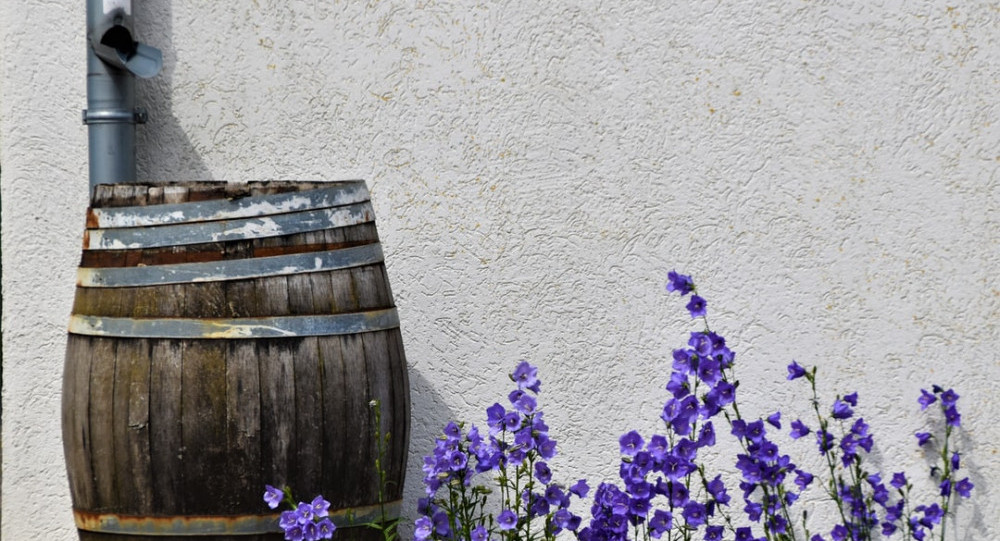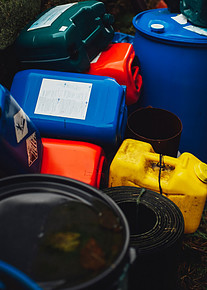Calling it an art may be a stretch but it is a skill that can be learned to help you survive. If done improperly can shorten your length of survival. Read this article to avoid some mistakes collecting rain water from the beginning.

Collecting rainwater for drinking purposes may seem simple enough, but there are many ways it can go wrong – some of which can actually be quite dangerous.
If you would like to start collecting rainwater in a way that is both safe and effective, make sure that you avoid these common rainwater collection mistakes.
Mistake #1: Using the Wrong Container
While there are plenty of containers that are capable of holding water, not all of them are suitable for collecting and storing drinking water. Some containers may leach dangerous chemicals into your water, while others are not opaque enough to block out the sunlight – which could encourage algae growth.
Dark-colored plastic barrels are ideal for collecting rainwater, but many other containers will work so long as they are large enough, opaque enough, and not coated with any chemicals that could leach into your water.
Wood barrels have been used for years and years. They will work but they are porous, are subject to grow algae, and periodically need to be replaced because they deteriorate. I recommend a BPA-free plastic barrel. Not as attractive sitting in the front yard but if placed properly will not have to be moved for a lifetime.
Mistake #2: Not Knowing if it is Legal in Your Area
Believe it or not, collecting rainwater is not completely legal in all fifty states. Several states have decided that rainwater is community property and not something that can be taken by rainwater collectors.
In other states, collecting rainwater is legal, but there are certain restrictions. In Kansas, for example, you may be required to apply for a permit before you are able to collect rainwater.
There is no Federal Law that governs collecting rainwater but there are restrictions from state to state and you can find the information you need from the link in the next paragraph.
If you want to make sure you stay on the right side of the law, check your state’s laws and regulations regarding the collection of rainwater before you begin. Read this article to find out of collecting rainwater is legal in your state.
Mistake #3: Not Collecting Enough Rainwater
Most people don’t realize how much water they use until it becomes scarce. It takes a lot of water to survive, even if you start skipping showers and laundry days.
If you are building a rainwater collection system for the purpose of disaster survival, be sure to calculate how much water you are going to need and how much your system is going to collect and store. Then go here to get a suitable container for storage and dispensing.
If you don’t, you may end up with a system that does not collect nearly enough water for you to live on. The more that you are able to collect, the better – in a disaster scenario, there is certainly no such thing as having too much drinkable water but you can not have enough.
I have some more resources on Water for Survival in this post.
Mistake #4: Not Rinsing Your Roof Before Collecting It
When the rain starts to pour, many people start collecting it right away. However, it is essential to let the rain rinse your roof for at least ten minutes before you start collecting it.
The reasons for this are obvious when you think about it. Dirt, plant material, feces, and all kinds of other debris gather on your roof, which means it will gather in your water too if you don’t give the rain a chance to wash it away.
There are ways to automate this but the most economical way is to do it manually. It is as easy as making the spout that dumps to your collection system swivel so the collection can be bypassed. This lets you collect only when you want to.
Mistake #5: Not Purifying Your Rainwater Before You Drink it
In theory, rainwater is completely pure and safe to drink. However, that assumes it doesn’t come in contact with anything before it lands in your collection barrel. In reality, your rainwater may be coming into contact with all kinds of unsavory things on its way down your roof and into your barrel.
The chances of getting sick from drinking rainwater that you collect may be slim – much slimmer than drinking water from an unknown stream or pond – but there is still a chance.
To avoid this risk, all you need to do is purify your water supply. It’s a simple precaution that could save you from a lot of misery and one that may even save your life.
Mistake #6: Purchasing a Rainwater Collection System
Unless you have loads of money to throw away, purchasing a pre-made rainwater collection system is a waste. Making your own rainwater collection system is fairly simple, and the instructions for doing so as well as the supplies you will need are both cheap (if not free) and readily available.
Pre-made rainwater collection systems, meanwhile, can cost upwards of $1000. There’s simply no real reason to spend that kind of money for something you can do yourself it just takes time and a little know-how.
In fact, with a little time spent searching, you can likely find all of the supplies you need – including collection barrels – for little to no cost at all, and building your collection system once you have the right supplies is a simple project. If you are particular and are building something to be proud of that improves the appearance of your house while being useful, check out the links I have here. You can buy these on Amazon and I will receive a small commission on the qualified products so please purchase through my links so I can continue to help others in this effort.
Mistake #7: Not Using a Collection Screen
If you plan to use the rainwater that you collect for any purpose other than watering your garden, a collection screen is essential. Simply putting a fine, wire mesh screen over your collection barrel will allow the water to pass through while blocking out unwanted debris such as leaves, dirt, bird poop, and more.
If these things don’t sound very appetizing, be sure to put a screen over your collection barrel. In addition to a mesh screen, you can also use fabric sheets or even a pre-filtering barrel.
Mistake #8: No Way for Getting Your Water Out
Sure, it’s possible to dip water out of a collection barrel using a cup or other small container, but there are more efficient ways to access the water you collect. Installing a spigot on your collection barrel is something that doesn’t take a lot of time, and it will likely save you a lot of time and hassle in the future.
If you want to really boost the amount of water that you are able to withdraw, you can even install a pump in your barrel. Small pumps are not as expensive as you might think, and they can make drawing large amounts of water from your barrel a breeze.
Either way, just know that there are better ways to go about getting your water than dipping it out of the top of the barrel. This simple bulkhead fitting is easy t install yourself in any barrel you have.
I am currently working on building a copy of my design that I have set up that we currently use to water our garden and continuously supply our stock of potable water. If you have questions, please leave a comment and I will reply. I am a licensed plumber, have extensive experience, have done a lot of research, and am willing to help.
Click the link in this paragraph or enter your info in the form on this page for Not By Water Alone if you would like a copy of my free guide to Be Ready Before You Have To Be! This guide will give you a list of 9 things you need and how to store and rotate within your normal grocery bill once set up.
Chad

Thank you so much for sharing such an informative post about collecting rain water! I have never thought that it is such a process. Only my grandparents did collect it when we visit them at the farmhouse so I never tried it before. Who would have thought that you need a permit to collect rainwater! That is insane! Will keep these tips in mind 🙂
Hi Nuttanee,
This is one of the survival skills that is so essential because lack of water is the first thing to shoften your chances for surviving.
Collecting rain water is something g you can set up and actually use for other purposes and if you do, you will Be Ready Before You Have To Be!
Thanks for stopping by! Come back now, ya hear!
Chad
Hi there,
Awesome article, thanks for sharing it!
I didn’t know that rainwater can be dangerous to drink. Good to know. I do collect rainwater but for my plants, not for me:)
However, I have bookmarked your article so I can read more about this subject. We never, I might need because we often go camping on the beach and if we get stuck, I can always collect rainwater. Just a question, please. Will I need to purify the rainwater if I collect it in a stainless container?
Thanks a lot!
Hi Daniella,
I am glad you have found this site to help you with your water collecting. It is awesome that you have already started collecting rainwater. Stainless steel is a great product for durability and longevity. The rainwater you collect is still full of stuff you do not want to drink.
Typically the natural process of evaporation and condensing back into rain will make really pure water. Now that you have collected it, what has it come in contact with. I assume it is from the gutter system off of your roof (most common). Even without that exposure the water is still and can have microbial growth if it sits for an extended period of time.
I would recommend if you are going to drink the water from the barrel, even if it is stainless steel to filter and purify the water even before storing it in an air-tight container. I have several suggestions to purify water on this page.
Water Clean Enough To Drink
Thank you for asking! I hope this helps!
Chad